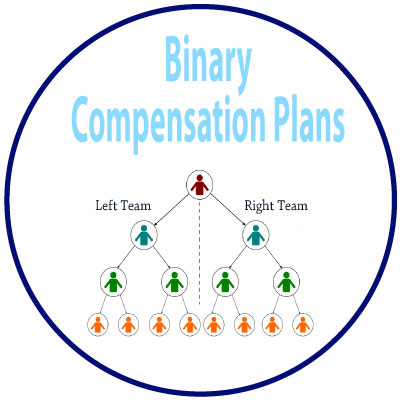 The binary compensation plan is one of the most popular multilevel compensation plans used today by new companies because it does what no other compensation plan type can do, and that is, it pays the upline on an unlimited number of levels of downline volume.
The binary compensation plan is one of the most popular multilevel compensation plans used today by new companies because it does what no other compensation plan type can do, and that is, it pays the upline on an unlimited number of levels of downline volume.
In a binary compensation plan, sales volume is accumulated from each independent representative’s left leg and right leg. Compensation is paid on accumulated unpaid volume in one of three ways.
Watch the video below to learn about the three flavors of binary compensation plans, binary plan golden handcuffs, how to slow down a runaway binary plan, and more.
Binary Basics
A binary compensation plan is structurally similar to a two-wide matrix. However, the compensation method for a binary plan is totally different.
Unlike other compensation plans that pay bonuses using percentages of a single commission period’s sales volumes, binary compensation plans pay threshold bonuses based on the accumulation of unpaid volumes on the “left” and “right” sides of a representative’s two-leg organization.
Compensation is paid to representatives when the volume of both legs meets or exceeds specific thresholds (50/50 approach) or when the volume of the lesser leg meets or exceeds specific thresholds (1/3, 2/3 approach).
Active representatives with unpaid volumes have their left and right side volumes rolled forward to the next commission period. Inactive representatives “lose” the accumulated unpaid volumes. Binary compensation plans count on the presence of representatives who go inactive to limit payouts.
No Perfect Compensation Plan
Every compensation plan type has its strengths and weaknesses, just like people.
For decades the mainstay of the direct selling channel was the generation breakaway compensation plan with stair-step compensation, but that plan is fading away like the horse and buggy did after automobiles were invented.
Today, new direct selling companies have unilevel, unigen, and binary hybrid compensation plans.
Today’s Question
“To binary or not to binary?”, is the question. So, let’s answer it!
“The Good”
Pays To Unlimited Depth
Binary compensation plans pay to unlimited depth.
All other types of multilevel compensation plans pay compensation upon the volume of a limited number of levels or generations of downline representatives. For top leaders, this means their downline organization will grow beyond the limits of their pay line when they are not paid through a binary compensation plan.
Power Legs
Because in a binary compensation plan there are only two spots to fill on an independent representative’s first level, there is spillover. Spillover is the placement of a representative not on one’s first level, but instead on the first level of a downline representative in your placement tree.
A power leg is defined as a leg that contains significantly more volume than the other leg. A power leg occurs when one of two situations is present:
- Your upline representatives are placing representatives into one of your legs; this is spillover.
- The representatives in one of your legs are building their businesses much faster than the representatives in your other leg.
When a representative has a power leg, he or she can focus on building just one leg of their placement tree, which makes the compensation plan easier for the representative with a power leg.
If you want to know more about power legs, read Three Flavors of Binary Compensation Plans – Which Is Best?
Weekly Compensation
Most binary compensation plans pay compensation weekly, which means people get paid more often than other plans which pay most often monthly.
Pays On Unpaid Volume
All other types of multilevel compensation plans pay compensation upon the volume generated in a commission period, most often monthly. When a new commission period starts, the volume generated in the past is irrelevant. With all other types of plans, you get paid only upon the volume generated in each commission period.
Binary compensation plans pay threshold bonuses based on the accumulation of unpaid volumes on the “left” and “right” sides of a representative’s two-leg organization. Unpaid volume this week is the sum of unpaid volume carried forward from the last period plus new volume generated this week.
Volume is carried forward from the last commission period when a company pays in cycles or when an independent representative has a power leg, but only when the representative is active.
Golden Handcuffs
When a representative isn’t active, any volume carried forward from the previous commission period and any volume generated in this period is “flushed”, which means it is removed from the system so that representatives inactive during this period won’t be paid upon it when they are active in future pay periods.
This effect is a golden handcuff. When you are paid through a binary compensation plan, you can lose more than just this pay period’s income when you are inactive; some of your future income may be lost as well.
In all other compensation plans, if you are inactive in one commission period, it simply means you are not eligible to earn compensation upon the volumes of other representatives. The damage done to your future income is zero. The effect of your inactivity is limited to the period in which you were inactive.
Pays Top Leaders The Most
Because compensation is calculated upon an unlimited number of levels of downline volume, binary compensation plans pay top leaders the most compared to other compensation plans. If you wish to attract successful leaders to your company, having a binary compensation plan can be helpful.
People Will Join Because Of Your Plan
Many of the people who have been successful in a company with a binary compensation plan who are seeking a new home will like your company better if your compensation plan is a binary plan. In fact, some of these people won’t join a new company without one.
Plan Appears Amazing
As explained in my article How To Slow Down A Runaway Binary Compensation Plan, unless you put into place a group of measures to slow down the payout, you will pay out too much.
One of the income limiting elements in a binary compensation plan is a cap on the number of binary bonuses that can be earned for each rank in your pay plan. While your compensation plan chart identifies these limits as “maximum binary bonuses”, many in the field interpret these amounts incorrectly as “how much you can earn” at each rank. Curiously, they don’t see the amounts as limits even though they are labeled as such. Instead, they see them as income potential.
So, while you publish these amounts as income limits, many in the field view them as good news, not bad.
“The Bad”
The Suffering of the Lower and Middle Class
While binary compensation plans reward top leaders the most, lower and middle-ranked representatives are not rewarded as well.
While First Order Bonuses and Fast Start Bonuses can help to raise the income of new representatives, binary compensation plans have larger deserts (periods without adequate sustenance) that hardy representatives must cross to make it to the promised land of higher incomes. Like pioneers, many die on the trail.
Leg Volume Balancing
In a binary compensation plan, the volume in your weakest leg determines how you will be paid. This means to get paid, you need to increase the volume in your weaker leg.
The best ways to do that are to (a) place your new personally enrolled representatives into your weaker leg and (b) focus your efforts on helping the representatives in your weaker leg to build their businesses.
It is counter-intuitive to think of your downline organization as two teams and that you should focus your efforts mostly on helping your weaker team because your compensation is based mostly upon their productivity.
Balancing leg volumes can be difficult to do.
Income Limits Per Rank
Healthy binary compensation plans include income limits per title (to slow the payout down and to encourage the building of stronger enrollment tree legs).
However, in no other type of multilevel compensation plan is there a limit on how much you can earn per rank. This is a negative attribute.
Unhappy CFO
Chief Financial Officers want to have predictable expenses. When expenses are unpredictable, they get real crabby fast!
The total percentage of field compensation paid in a binary compensation plan can vary significantly from one commission run to another. In addition, binaries are famous for their “creep”, the slow but steady increase in the average percentage of compensation paid out in each commission run.
Expect Compensation Plan Changes
It is very difficult to get the business rules of a binary compensation plan financially right the first time. If you’d like to know why call me with your compensation plan in hand and we’ll talk about it.
While steps can be taken to slow the payout down, still it is common for direct selling companies with binary compensation plans to have the need to amend their plans later for three primary reasons:
- The payout exceeds the budget.
- The plan is paying out too much to the wrong people and not enough to the right people.
- Recruiting and selling activities are below expectations.
Do You Need Help With Your Binary Compensation Plan?
Sylvina Consulting designs and improves compensation plans. We also professionally evaluate and improve compensation plans designed by others.
The binary compensation plan pays the upline on an unlimited number of levels of downline volume.
How can you do that? Won’t you pay out too much? Unless you put into place a group of measures to slow this runaway train of a plan down, you will pay out too much.
About The Total Payout Cap
The purpose of the commission period payout cap is to give a direct selling company the power to set a budget for compensation plan earnings as a percentage of a commission period’s volume.
Interestingly, most independent representatives don’t think of the payout cap in the same way a company sees it. Reps read it as “you will pay out this much” instead of “you won’t pay out more than this much.”
It is never good news when a company chooses to enforce a payout cap because when this happens, reps experience an undeserved “pay cut”.
How to Calculate Maximum Payout
In addition to implementing the steps above, it is important to model the payout of your binary compensation plan to calculate the maximum payout.
Conclusion
In today’s immediate gratification culture, representatives would prefer to be paid on every drop of weaker leg volume so many new binary compensation plans are designed without cycles.
I say the binary compensation plan is like a runaway freight train. We need to slow down the payment of commissions and bonuses. Using cycles is one way to do it, but there are many others.
Sylvina Consulting designs compensation plans. We also professionally evaluate and improve compensation plans designed by others.
To learn more about multilevel compensation plans, watch our videos and attend our Direct Selling Edge Conference.

 Jay Leisner, the President of Sylvina Consulting, is a top compensation plan and direct selling expert, a trusted adviser to new and established network marketing and party plan companies. For more than 30 years, Jay has enjoyed assessing and improving network marketing, party plan and referral marketing companies across the globe.
Jay Leisner, the President of Sylvina Consulting, is a top compensation plan and direct selling expert, a trusted adviser to new and established network marketing and party plan companies. For more than 30 years, Jay has enjoyed assessing and improving network marketing, party plan and referral marketing companies across the globe.
Leave a Reply